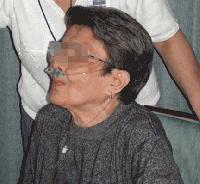(presentation based on two cases seen by DdeC on 3rd May 2003. Thanks to Dr Stewart Robinson for comments.)
Corrections and suggestions to D de Castro please.



reference ranges:
blood Hb: adult male 140-170 g/l, adult female 120-155 g/l.
PaO2: varies with age etc. Normally about 13 kPa (100
mmHg)
Mr Blue and Mrs Pink are seen on the same night at an emergency clinic. Both
are 65 and both have respiratory difficulties.
Both patients complain of severe asthma and are treated with nebulised bronchodilator
by inhalation. Both have had symptoms for about ten years and are markedly
restricted in their daily activities by breathlessness. However, both have
had increased cough and symptoms in the last week. Mr Blue has been 'unable
to sleep for the last four nights' in spite of four-hourly nebulised bronchodilator,
and has clear sputum. Mrs Pink has a dry cough, her breathlessness is worse
than usual and she feels that her general health is going downhill.
* what do you think is going on here--are these presentations consistent with asthma?
This is not asthma. These two patients have more permanent types of lung disease, which are described as 'chronic' (present for a long
period of time) disease. There is a similarity with asthma in that their lung conditions are 'obstructive'--the airways are narrowed--but in asthma the obstruction is intermittent.
These cases are both forms of the common "Chronic Obstructive
Respiratory Disease" (CORD) or 'COPD' for "pulmonary" etc. Dr Poole will lecture on this topic during this course.
* Is a patient's formulation of his or her illness necessarily reliable?
No.
Mr Blue has an arterial hemoglobin (Hb) saturation (Sa02) by fingertip pulse
oximetry of 90% and Mrs Pink of 95%.
* The pulse oximeter uses the relative absorbance of two wavelengths of light
by arterial blood to estimate Sa02. What value is expected in health?
96-100%
* Why is Mr Blue's 'saturation' reduced, and what would be the effects of
this?
Transfer of oxygen from the bronchi to the pulmonary capillaries is impaired
due to lung disease, so hemoglobin is incompletely oxygenated. Delivery
of oxygen to tissues is reduced.
* How would the interpretation of Sa02 be affected by anemia?
High Hb saturation with oxygen of does not ensure adequate oxygen delivery
to tissues if the concentration of Hb is lacking, so in an anemic patient,
blood oxygen content may be low in spite of a normal Sa02.
* How would the interpretation of Sa02 be affected by carbon monoxide exposure
(smoker) or poisoning?
Carbon monoxide and hemoglobin form carboxyhemoglobin (COHb) rather than
oxyhemoglobin. Although oxygen content of the arterial blood can be much
reduced by carbon monoxide inhalation (see following notes), the pulse oximeter
includes COHb in the reported saturation, which is therefore misleadingly
high.
Carbon monoxide combines with hemoglobin to form carboxyhemoglobin. Since
carbon monoxide and oxygen react with the same group in the hemoglobin molecule,
carboxyhemoglobin is incapable of carrying oxygen. The affinity of hemoglobin
for carbon monoxide is two hundred times greater than for oxygen, and at
equilibrium 1 part of carbon monoxide in 1500 parts of air will result in
50 percent conversion of hemoglobin to carboxyhemoglobin. Carboxyhemoglobin
also interferes with the release of oxygen from hemoglobin. This further
reduces the amount of oxygen available to the tissues and explains why tissue
anoxia appears in the carbon monoxide-poisoned person at levels of arterial
oxyhemoglobin concentration well tolerated by the anemic patient.[...]
The most characteristic sign of carbon monoxide poisoning is the cherry red
color of skin and mucous membranes, which is due to the bright red carboxyhemoglobin.
(Harrison's 9th ed. p. 956)
Because cigarette smoke contains 2 to 6 percent carbon monoxide, smokers inhale concentrations as high as 400 parts per million (ppm) and develop elevated carboxyhemoglobin (COHb) levels. While the range of COHb for smokers is 2 to 15 percent, levels for nonsmokers are near 1 percent. The average COHb level for moderate cigarette smokers is 5 percent. Carbon monoxide produces its adverse effects by reducing the amount of available oxyhemoglobin and myoglobin, and displacing the oxygen-hemoglobin dissociation curve to the left. Chronic, mild elevations of COHb due to smoking are a common cause of polycythemia and may produce subtle impairments of central nervous system function. (Harrison's 9th ed. p. 938)
On examination Mr Blue is mildly centrally cyanosed while Mrs Pink is pink, but has a marked increase in resting respiratory rate and appears anxious.
* what is 'cyanosis' and what is it due to? What might cause cyanosis in the hands and feet (acrocyanosis, peripheral cyanosis)? In the lips and face ('central' cyanosis)? What does the presence of cyanosis imply about the Hb level?
Cyanosis. A bluish discoloration of the skin or mucous membranes caused by an excess of reduced Hb in the blood. Cyanosis is not usually detectable until the arterial O2 saturation (SaO2) is < 85%. It is less readily detectable if anemia is present and more readily seen in polycythemia. Peripheral cyanosis is associated with stasis, in which oxyhemoglobin is reduced more than it normally is because of the prolonged peripheral blood transit time. Central cyanosis results from arterial hypoxemia and affects warm mucous membranes as well as cooler skin. (Merck Manual, section 6 ch. 63)
The physical sign of hypoxia is central cyanosis. As an index of the degree
of hypoxia, it is unreliable, rarely being detectable before the arterial
PO2 has dropped to 8.0 kPa (60 mmHg), and being critically dependent on the
quantity of circulating reduced hemoglobin (approximately 50 g/l) and so
on the total hemoglobin. Cyanosis is therefore rare and very serious in anemia,
but common and not serious in polycythemia. (Lane's Respiratory Disease
p. 287)
Note that the word 'reduced' in the preceding quotation is badly chosen: chemically reduced hemoglobin, methemoglobin, is a separate chemical species. "De-oxygenated" is a better description of the Hb molecule contributing to cyanosis.
Mr Blue complains of exhaustion with coughing and is sent to a hospital.
Mrs Pink asks about a prescription for a mild relaxant (diazepam, a benzodiazepine)
to ease her state.
* Can you suggest a reason why Mrs Pink is so troubled by dyspnea when her
oxyhemoglobin saturation is reasonable?
She has to work hard to breath, day and night. By increasing her respiratory performance (raising her respiratory rate, tidal volume, and cardiac output) she manages to maintain her Sa02 in the normal range
at rest. However, she is likely to become hypoxic with exertion.
She may also be sensitive to a moderate increase in blood CO2 (hypercapnia), which normally produces a stronger drive to ventilation even than hypoxia. Her case is an example of the so-called 'pink puffer' seen in CORD
patients at the 'emphysema' end of the spectrum.
* Can you suggest why Mr Blue is not troubled by this (dyspnea) in spite
of a clearly reduced Sa02?
His sensitivity to CO2 is reduced. Why this occurs is not clear, but it
is associated with a chronically raised PaC02. Because of this his drive
to breathe is dependent on brain input from oxygen chemosensors, i.e. a hypoxic
drive. An important clinical implication of this is that if he is given
a high FIO2 (high-dose inhaled oxygen-by way of a special 'rebreathing' face mask), this remaining stimulus to ventilation
is lost, and he will become very hypercapnic and may die. His case is
an example of the 'blue bloater' type of CORD patient, seen in those with
the 'chronic bronchitis' form of the disease. The word 'bloater' is used in this context because these patients may go on to develop right heart failure with peripheral edema due to obstruction to the pulmonary circulation.
* Is there any reason not to comply with Mrs Pink's request?
Respiratory depression, i.e. suppression of the brain mechanism driving ventilation,
is brought about strongly by potent sedative agents (anesthetics, opiaties,
barbituates), but does occur also with tranquillisers, especially when respiration
is compromised, and may be fatal.
references:
The Merck Manual's page on COPD. As usual,
this book surveys the topic quickly and clearly.
Poole PJ, Bagg B, Brodie SM, Black PN: Characteristics of patients admitted to hospital with chronic obstructive pulmonary disease. NZMJ. 1997 Jul 25;110(1048):272-5. Abstract available here . This article, by one of your lecturers in this course, gives a local perspective on the condition by describing Auckland patients with COPD.
Huib A M Kerstjens: Stable chronic obstructive pulmonary disease. BMJ 1999;319:495-500
. What, if any, treatment is effective in COPD? Corrections and suggestions to D de Castro please.
(presentation based on two cases seen by DdeC on 3rd May 2003. Thanks to Dr Stewart Robinson for comments.)